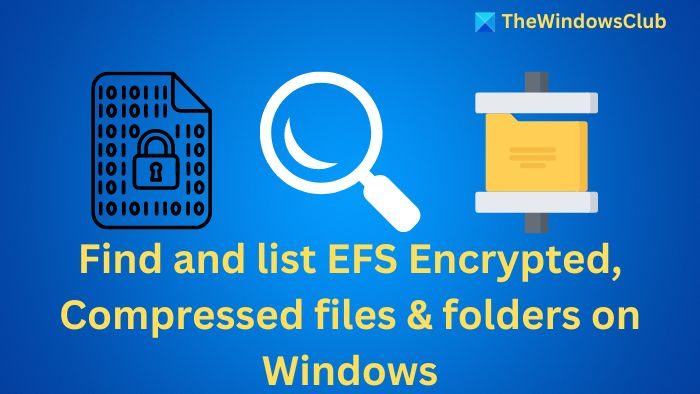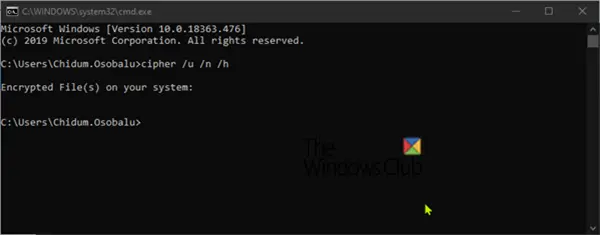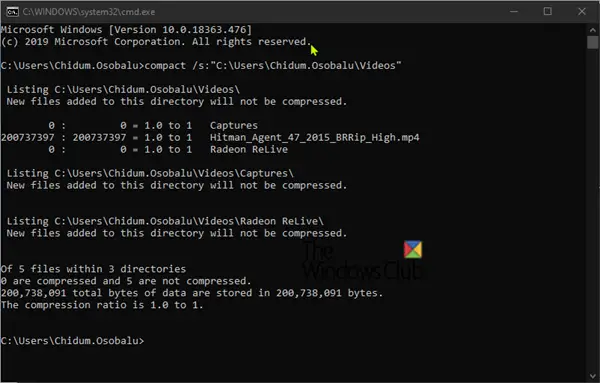Today’s post will explore a relatively simple way to search, find, and list all your EFS encrypted and compressed files/folders on Windows 11/10. You will find this how-to guide essentially helpful if your EFS encrypts and/or compresses most of your files and folders, which, over time, builds up significantly and is scattered across various locations on your PC’s HDD/SSD. In this case, you may need to run a command that will crawl your entire PC’s drive or specified locations to have these files and folders listed and presented to you, which you can now easily view at a glance.

What happens when you encrypt or compress files and folders?
When you encrypt a file or folder with EFS in Windows 11/10, its icon will have a lock overlay at the top right corner to indicate that it’s an EFS-encrypted file or folder on NTFS drives protected from unwanted access.
When you compress files and folders on an NTFS drive, they will have a double blue arrow icon overlay at the top right corner to indicate that they are compressed. NTFS file system compression can save disk space; compressing data can adversely affect performance.
When you execute a command to search, find, and list all EFS encrypted and compressed files on Windows 11/10, you can specify if the result will output within the command line interface or be exported to a txt file, which you can read with any text editor, like Notepad.
Find & list EFS Encrypted files & folders on Windows 11/10
1) To find and output list within the command-line interface

- Press the Windows key + R, type CMD in the dialog box, and press Enter to launch a command prompt.
- In the prompt, type the following command and press Enter:
cipher /u /n /h
Depending on the volume of encrypted files, Windows will now take some time to crawl all NTFS local drives for all encrypted files belonging to the currently logged-on user and will output a list in the command prompt.
If you do not have any encrypted files, the output will be the same as shown above.
Read: Difference between NTFS, FAT, FAT32, and exFAT file systems.
2) To find and export list to a txt file
- Open command prompt
- In the prompt, type the following command and hit Enter:
cipher /u /n /h > %UserProfile%\Desktop\EncryptedFilesList.txt
- When the scan command completes, the list will be exported to your desktop in a file named EncryptedFilesList.txt. You can double-click the file to view the list.
Search & list Compressed files & folders on Windows 11/10
1] To find and output list within the command line interface
- Press the Windows key + R, type CMD in the dialog box, and press Enter to launch a command prompt.

- In the prompt, type the following command and hit Enter:
compact /s:"<Path of directory>"
Replace <Path of directory> place-holder in the command with the full path of the folder and drive you want to scan for compressed files and folders in it and its subfolders. E.g.:
compact /s:"C:\Users\Chidum.Osobalu\Videos"
Depending on the volume of compressed files, the command will take some time to complete, then output a list in the command prompt.
2] To find and export list to a txt file
Use this option if you have a long list of compressed files and folders to review in a text file.
- Open command prompt
- In the prompt, type the following command and hit Enter:
compact /s:"<Path of directory>" > "%UserProfile%\Desktop\Compressed_Files_Folders_List.txt"
- Replace <Path of directory> place-holder in the command with the full path of the folder and drive you want to scan for compressed files and folders in it and its subfolders. E.g.:
compact /s:"C:\Users\Chidum.Osobalu\Documents" > "%UserProfile%\Desktop\Compressed_Files_Folders_List.txt"
- When the scan command completes, the list will be exported to your desktop in Compressed_Files_Folders_List.txt.
Trust this helps you list and view all your EFS encrypted and compressed files/folders at a glance.
Read: File not found or No read permission, Compressed (Zipped) Folders Error
How do you find out if a file or folder is encrypted?
Right-click the file or folder on Windows, select Properties, and click the Advanced button. The files are encrypted if the Encrypt contents to secure data checkbox is selected.
Is a compressed file encrypted?
No, a compressed file is not encrypted by default. Compression reduces file size by removing redundant data, and it can be password protected, but that doesn’t mean it is encrypted.
Leave a Reply